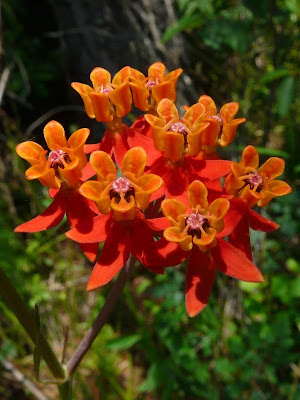
The photograph above is typical of the east-west oriented dune and swale (also called swell and swale) formations in northwest Indiana. This topography is the result of glacial Lake Michigan slowly retreating after an outlet formed in the Valparaiso Moraine that had previously served as the southern boundary of the lake. The dunes (or swell) are characterized by savanna and sand prairie; the swales consist of shrub swamps and emergent marshes. I was in this part of the state last week to complete surveys for federally endangered Karner Blue Butterflies.
The flora in the Oak Openings region of northwest Ohio bares a striking resemblance to that of northwest Indiana, though this region lacks the higher dunes and organized swell and swale pattern found in northwest Indiana. The Oak Openings region formed as glacial Lake Warren receeded after the last ice age. The resulting plant communities consist of sand prairie, savanna, and wet prairie. Disturbances including fire, natural hydrological fluctuations, and impacts from macrofauna kept these plant communities from undergoing succession and becoming forests. Today, we lack the macrofauna and instead have to rely on bulldozers and ATVs to create disturbances necessary to keep the wet sand flats like that shown below from undergoing succession. Areas like this harbor numerous rare plants found nowhere else in the state. I was in the Oak Openings region for the Michigan Botanical Club's annual spring foray.

Lupinus perennis ssp. perennis var. occidentalis (Wild Lupine, below) is blooming right now and is a common component in the sand prairies and oak savannas. This species is found throughout the Great Lakes states and along the east coast of the United States.

Often, Lupinus perennis ssp. perennis var. occidentalis is found in association with Lithospermum caroliniense var. croceum (Carolina Puccoon), as in the photograph below. Lithospermum caroliniense var. croceum is known from a large area through North America ranging from Ontario to Colorado to Arakansas to New York.

Another species of dry sandy soils in prairies, savannas, fields, and sand blowouts is Asclepias amplexicaulis (Clasping Milkweed), shown below. Plants of this species that I saw in northwest Indiana had not yet begun to flower when I saw them last week; however, this plant in the Oak Openings had begun to bloom. Asclepias amplexicaulis is known from most of the eastern half of North America.

In sand blowouts in northwest Indiana, I came across Hudsonia tomentosa (Woolly Beachheather, below). This species, known from most of the northeastern half of North America, is considered threatened in Indiana and extirpated from Ohio. Throughout its range, Hudsonia tomentosa grows in beaches, pine woods, and barrens, and on sand hills.

Lastly, in an oak savanna at Kitty Todd Nature Preserve, we saw Cypripedium parviflorum var. pubescens (Greater Yellow Lady's Slipper, below). Although it is known from most of North America, Cypripedium parviflorum var. pubescens is a species of concern in many states, and always provides a thrill. You can find this showy orchid in a variety of habitats including forest, savanna, prairie, and fen.






















 Laundry: We do a lot of laundry, and all but the filthiest is washed in cold water. This saves natural gas, puts less carbon into the atmosphere, and saves money. And we only take cold showers…...ok, that might be an exaggeration.
Laundry: We do a lot of laundry, and all but the filthiest is washed in cold water. This saves natural gas, puts less carbon into the atmosphere, and saves money. And we only take cold showers…...ok, that might be an exaggeration.

























